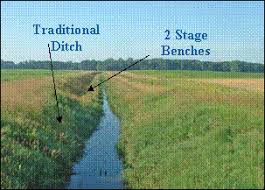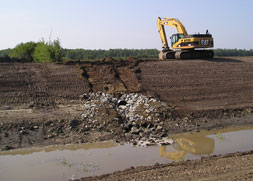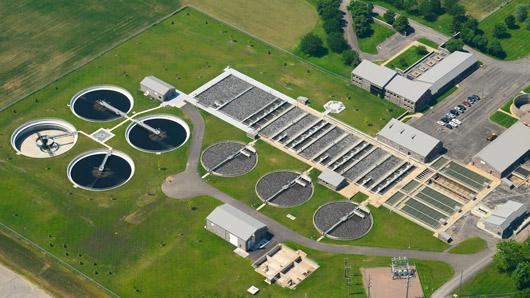Photo: Mower SCWD
If there is anything close to a silver bullet to yield a better bottom line for farmers while also improving water quality, it may be soil health.
As research continues, farmers, researchers, and watershed districts will likely have new opportunities to work together to improve soil health while helping reduce excess agricultural nutrients entering water systems.
Joe Magner, University of Minnesota researcher with the Department of Bioproducts and Biosystems Engineering, envisions opportunities for farmers to implement two-stage ditch technology that will improve water quality while benefiting soil health.
Photo: Dan Mecklenburg, Ohio Department of Natural Resources, and Andy Ward, Ohio State University
Storing more water and improving quality
The two-stage ditch structure bio-mimics a natural stream, allowing for more water storage to take place within the ditch geometry than would naturally happen.
When water levels increase, water rises up out of the low flow channels and spills out over the benches, interacting with the soil and vegetation on the benches.
As fine sediment and nutrients carried by the water and within the sediment is trapped on the benches, the roots of plants—such as cattails—planted in the benches take up the nutrients through the water.
At the end of a summer season, the cattails in the benches have absorbed phosphorus and other nutrients that can be re-applied to fields. Not only do the cattails provide nutrients to the soil, minimizing farmers' fertilizer costs, they contribute much-needed organic carbon to heavily utilized and intensively managed agricultural soil systems.
Magner notes that because Minnesota is so cold, cover crops can be challenging to grow. Harvesting cattails and putting them on the soil offers an alternative to planting cover crops for putting organic carbon back into the soil.
Photo: BWSR
Benefiting both soil and water health
Magner and fellow researchers have published papers about the two-stage ditch technology and water quality improvement tools, and have been learning from farmers in other states about the soil health benefits farmers are seeing when they focus on increasing organic carbon in their soils.
"How we measure and define soil health and biology could be one way to both help farmers stay afloat and improve environmental outcomes," notes Magner.
"The University of Minnesota is developing some tests and has some ideas about BMPs that are grassroots-driven, which is one of the most exciting things about this focus on soil health. In states like Indiana, the core of where focus on soil health improvements has taken place to date, the government is not creating incentives - farmers are choosing to improve the health of their soil and seeing results in input cost reductions (needing to buy less fertilizer) and, in some cases, experiencing higher yields."
Photo: Ohio State University
Magner gives the example of nitrogen fertilizer to describe the field - ditch connection important to the two-stage ditch treatment train he researches. Whether injected or placed on the soil surface, nitrogen fertilizer inevitably gets moved into what can be referred to as the soil nitrogen pool. Within the upper topsoil horizon, the soil incorporates nitrogen and phosphorus. If the topsoil is eroded, or if nitrogen or phosphorus is leached from the topsoil, it can end up in waterways.
The two-stage ditch provides a nutrient-trapping mechanism, in the form of cattail root and plant systems, located down-gradient of the farm fields. The trapped nutrients and organic carbon contained in the cattails can be re-applied to fields in the form of plant-matter fertilizer.
Investing now for long-term gain
Investing in building organic phosphorus application into production and increasing soil biological health shows little short-term profit. In the long term, however, benefits are at least two-fold.
Photo: Gary Sands, University of Minnesota
First, building soil organic carbon content supports healthier soil that requires less purchased fertilizer inputs. Second, cultivating and applying natural phosphorus sources can help farmers head off an anticipated shortage of that input.
Phosphorus for fertilizer use has been plentiful to date, but Magner warns of a time when that may no longer be the case.
"Within the next 25 years there will be a severe shortage of phosphorus fertilizer, and we will run out unless new mines are found," says Magner. "Putting an organic form of fertilizer that is both a phosphorus and organic carbon source back into the ground helps to build up the biological health of the soil."
Connecting with local government partners
Magner sees Minnesota's watershed districts as key members of creating partnerships around the state to help farmers improve the health of their soil. "Soil health is an issue everywhere in the state, and watershed districts are in one of the best positions to reach out and communicate about how to improve soil health and work together with communities to implement soil health BMPs."
Magner welcomes coordinating with interested watershed districts to determine if two-stage ditches are an appropriate tool for improving soil health in their area.












